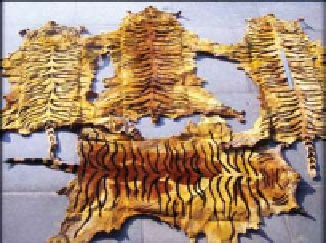Biology Reference
In-Depth Information
(a)
(b)
(c)
Figure 14.1
If illegal products are not highly processed, such as the tiger skins (a), then DNA
evidence is not required for species identification, but make be required to match an individual
skin with other evidence such as skeletal remains (b). (c) In other cases, such as the identification
of threads from a shawl containing hairs from the Tibetan antelope (shatoosh) that is CITES listed,
DNA analysis may be required to identify the fibres to a specific species (Images provided by
Dr Surendra Goyal, Wildlife Institute of India, Chandrabani, India)
and other trace evidence such as hairs, feathers and larvae can provide a crucial link
and act as associative evidence.
Crimes against animals
Cruelty to animals, illegal hunting, poaching and destruction of habitat are illegal
activities in many countries that may lead to an investigation. DNA transferred from
the animal to the human, the animal to an object or the human to the animal may
provide the forensic evidence to support allegations of this type.
In the examples above there are two main questions that the forensic scientist
should address: what species is this?, and do these two samples come from the
same organism? Different types of tests are required to address these issues. The
tests described in this chapter are all DNA-based. If there is morphology present
then microscopy can, in certain circumstances, provide the answer to the questions
above, but if the material is as a bloodstain or in trace amounts, then DNA typing
offers the best opportunity to determine either a species or an individual organism.



